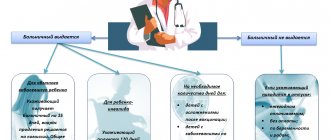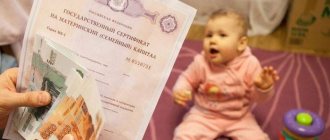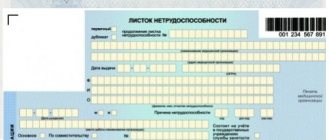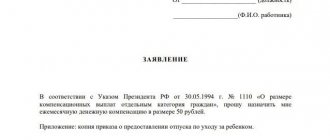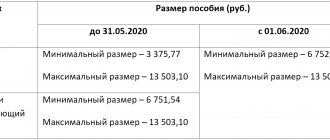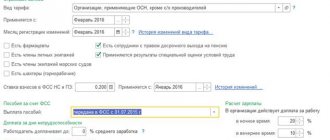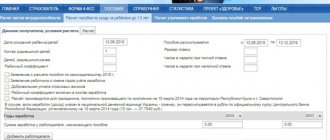DLDETI: decoding
The insurance period for the purposes of assigning an insurance pension includes not only periods when a person worked under an employment contract (Part 1 of Article 11 of Law No. 400-FZ dated December 28, 2013), but also when he did not directly perform his labor function, although the employment contract continued to act with him. These are, for example, periods of receiving compulsory social insurance benefits for temporary disability, as well as periods of one parent caring for a child until he reaches the age of one and a half years, but not more than six years in total if there are several children in the family (clause 2 ,3 part 1 article 12 of the Law of December 28, 2013 No. 400-FZ, article 256 of the Labor Code of the Russian Federation).
At the same time, at the end of leave to care for a child up to one and a half years old, a parent has the right to take leave to care for a child up to three years old (Article 256 of the Labor Code of the Russian Federation). That is, in total, a parent can be on leave for a maximum of 3 years. At the same time, the second half of this vacation is no longer included in the insurance period. Accordingly, one and the other leave must be noted in the employee’s individual information, namely in subsection 6.8 of section 6 of RSV-1, differently.
Therefore, when granting parental leave (clause 37.19 of the Procedure for filling out the RSV-1):
- up to one and a half years old, the code “CHILDREN” is indicated to the mother or father of the child;
- from one and a half to three years of age, the mother or father of the child is given the code “DDILID”;
- up to three years of age, another relative of the child or his guardian is indicated with the code “CHILDREN”. After all, such leave can be granted, for example, to a working grandmother or grandfather when caring for a grandchild, as well as to another relative (clause 19 of the Resolution of the Plenum of the Supreme Court of the Russian Federation dated January 28, 2014 No. 1).
What is this code: decryption of the Pension Fund of Russia
What is “VRNETRUD” in SZV-STAZH? What is the meaning of this code? In accordance with the Instructions for filling out SZV-STAZH, the code “VRNETRUD” is a period of temporary incapacity for work (Resolution of the Board of the Pension Fund of the Russian Federation dated January 11, 2017 No. 3p). That is, these are all sick leaves of an employee of an organization or individual entrepreneur.
In the SZV-STAZH report, section 3 shows information about the periods of work of the employee, which are counted towards the insurance period. Important: in addition to the work itself, the length of service includes the period in which the employee received social insurance benefits for temporary disability. In other words, an officially registered period of illness (clause 2, part 1, article 12 of the Federal Law of December 28, 2013 No. 400-FZ). This means that sick days must be included in the SZV-STAZH reporting for 2017.
Submission of individual information since 2017
Contribution payers will have to report for the last time using the RSV-1 form, which also contains personalized accounting data, at the end of 2021. For the periods of 2021, policyholders will have to submit reports to the tax authorities. And individual information, as before, will need to be submitted to the Pension Fund. But not 4 times a year, as RSV-1 is now submitted, but only once - no later than March 1 of the year following the reporting year (Clause 2, Article 11 of Law No. 27-FZ dated 01.04.1996, as amended, valid from 01/01/2017).
DLCHILDREN is a code designation of the status of a “maternity leaver” in the personalized accounting system. It must be affixed for the corresponding category of employees registered with the employer. This type of information is submitted to the Pension Fund of the Russian Federation, despite the fact that the Federal Tax Service is responsible for collecting contributions and reporting on them. From January 2021, employers must submit two types of reports to the Pension Fund of the Russian Federation that serves them - monthly information about all insured persons employed by them and an annual form with information about the insurance experience for all employees - SZV-STAZH, a sample of which you will find.
Codes for filling out the SZV-STAZH form with explanation
This reporting also includes a section with information about accrual of payments to compulsory pension insurance made in relation to the income of each employee personally.
However, information about the length of service was not included in the new reports submitted to the Federal Tax Service as it is not related to the calculation and payment of contributions. Control over data on length of service remained with the Pension Fund of Russia, but the submission of information about it became annual. It is for this annual reporting that a new reporting form (SZV-STAZH) was introduced. The form reflects information about the policyholder (name, registration number, TIN, KPP), the type of information submitted (initial, supplementary, intended for calculating a pension) and the year for which the report is submitted. To enter basic information (about the length of service of employees), there is a table reflecting information: about full name.
and SNILS of employees (columns 2–5); the period of their work for the reporting year (columns 6–7); working conditions and periods,
Children's Pension Fund - what is it?
The designation of codes by type of length of service of insured persons working at an enterprise or individual entrepreneur is indicated only in the SZV-STAZH. The form template was approved by Resolution No. 3p dated January 11, 2017 (issued by the Board of the Pension Fund of the Russian Federation). A third section is provided for information about different periods of work for all insured employees of the employer.
This set of information is necessary for pension structures to identify the total insurance period for each person. The final value of this indicator will be used when calculating the pension. Only those time intervals that, according to the legislation, can be classified as insurance experience are subject to summation. This category also includes some periods when an enterprise or individual entrepreneur concluded an employment contract with a person, but the employee did not actually fulfill his duties and was not at his workplace. An example is leave taken to care for children until they reach the age of 1.5 years.
CHILDREN - the PFR decoding is given as leave for children aged 1.5-3 years. This is the time when a woman did not actually perform a labor function due to being on maternity leave. This type of leave is provided for by labor law and cannot be interrupted at the initiative of the employer. Its peculiarity is that from the moment the child turns one and a half years old, the time spent by the employee at home ceases to be taken into account in the insurance period. But the right to include these months in the work experience is not lost.
DLDETI and CHILDREN - what is the difference:
- the first indicator is used to identify the category of workers who care for children aged 1.5-3 years, the length of service is not insurance;
- The code designation CHILDREN is used for a group of employees who are on leave to care for their children, subject to the inclusion of this time in the insurance type of experience (the child’s age must be up to 1.5 years).
In both cases, codes are provided for workers who are not working to care for their children. This only applies to moms. For grandparents and other relatives and guardians, the reporting form offers a separate code designation (DETIPRL). The codes must be entered in column 11. The full list of codes is given in the Parameter Classifier, which is approved by Resolution No. 3p. Despite the fact that only the period of caring for small children up to 1.5 years is important to determine the total insurance period, all types of leave and length of service must be indicated in the information so that the pension authorities have the opportunity to accumulate a full range of information about the work activity of each insured person .
SZV-STAZH codes with interpretation
extending beyond the reporting (settlement) period LOTH VACATION - stay on paid leave VRNETRUD - period of temporary incapacity for workQUALIFY - advanced training without work SOCIETY - performance of state or public duties OTSTRAN - removal from work (non-admission) through no fault of the employee SDKROV - days of donating blood and its components and provided in this regard, rest days SIMPLE - downtime due to the fault of the employer UCHALETS - additional leaves for employees combining work and studyNEOPLDOG - period of work of the insured person under the contract GPHNEOPLAVT - period of work of the insured person under the author's contract DLCHIDS - parental leave up to 1.5 to 3 years of the Chernobyl Nuclear Power Plant - additional leave for citizens affected by the Chernobyl Nuclear Power Plant disaster -
- unpaid time participating in a strike;
- other unpaid periods (with the exception of periods with codes DLDETI and Chernobyl NPP)
- one additional day off per month without pay for women working in rural areas;
- unpaid leave of up to one year provided to teaching staff;
- unpaid periods of suspension from work;
- downtime due to the fault of the employee;
- leave without pay;
Certificate of status of the Pension Fund of the Russian Federation
The Pension Fund of the Russian Federation was formed in accordance with Resolution of the Supreme Council of the RSFSR dated December 22, 1990 No. 442-1 “On the organization of the Pension Fund of the RSFSR” for the state management of pension finances in the RSFSR.
This resolution determined the status of the Pension Fund of the Russian Federation as an independent financial institution operating in relation to the Law of the RSFSR “On Banks and Banking Activities in the RSFSR” and reporting to the Supreme Council of the RSFSR (in accordance with the resolution of the Council of Ministers - Government of the Russian Federation dated 22 September 1993 No. 958 “On the transfer of organizations and institutions to the jurisdiction of the Council of Ministers - the Government of the Russian Federation”, it was established that the Pension Fund of the Russian Federation is under the jurisdiction of the Council of Ministers - the Government of the Russian Federation and is accountable to it).
Resolution of the Supreme Council of the RSFSR dated December 22, 1990 No. 442-1 also established the provision that the Fund’s funds are not included in the republican budget of the RSFSR, other budgets and funds and are not subject to withdrawal. Later, this norm was provided for in all regulatory legal acts regulating the activities of the Pension Fund of the Russian Federation.
Thus, funds intended for pension provision were allocated from the state budget to the independent budget of the RSFSR Pension Fund (while remaining state property).
It should be noted that this resolution also established the amount of social insurance contributions obligatory for payment by all enterprises and organizations, regardless of their form of ownership and subordination.
Under the previous system, when funds intended to finance the payment of state pensions were part of the state budget, it was possible to borrow these funds for other state needs (in addition to pension payments), which negatively affected the financial sustainability of the pension system, that is, the ability The pension fund maintains the existing level of solvency in the event of possible adverse external and internal impacts on financial flows.
With the establishment of autonomy of the pension budget, the Fund's income ceased to be included in the budgets of other levels, a step was taken towards insurance principles and increasing the efficiency of the state pension system in the Russian Federation, and the foundations were laid for achieving long-term financial sustainability of this system.
During the period that lasted from the formation of the Fund until January 1, 1992, the Pension Fund of the RSFSR carried out its activities on the basis of the Temporary Regulations on the Pension Fund of the RSFSR and the Procedure for the payment of insurance contributions by enterprises, organizations and citizens to the Pension Fund of the RSFSR, approved by a resolution of the Supreme Council of the RSFSR dated January 30, 1991 No. 556-1, which established provisions similar to the provisions of Resolution of the Supreme Council of the RSFSR dated December 22, 1990 No. 442-1.
On January 1, 1992, in accordance with the resolution of the Supreme Council of the Russian Federation of December 27, 1991 No. 2122-1 “Issues of the Pension Fund of the Russian Federation (Russia)” the Regulations on the Pension Fund of the Russian Federation (Russia) and the Procedure for payment of insurance contributions by employers and citizens to the Pension Fund of the Russian Federation (Russia).
These documents also contained provisions on the status of the Pension Fund of the Russian Federation, according to which the Pension Fund of the Russian Federation was an independent financial and credit institution, and its funds were in the state ownership of the Russian Federation and were not included in budgets or other funds and were not subject to withdrawal.
The Pension Fund of the Russian Federation was entrusted with the responsibility to ensure the collection and accumulation of insurance contributions necessary to finance the payment of state pensions.
According to the above-mentioned regulatory legal acts, the Pension Fund of the Russian Federation carried out functions related exclusively to the financial component of the pension system (collection of insurance contributions, their accumulation, control over the receipt and expenditure of funds, etc.).
The Pension Fund of the Russian Federation financed the payment of pensions, and the functions of assigning and paying pensions were performed by social protection authorities.
In this regard, it is worth mentioning the Decree of the President of the Russian Federation of May 29, 1993 No. 787 “On the management of pension provision in the Russian Federation”, according to which the intervention of the Pension Fund of the Russian Federation and its branches in the operational activities of social protection bodies and the transfer of functions to it the appointment and payment of pensions were considered unacceptable.
At the same time, there was a situation when the Pension Fund of the Russian Federation carried out not only financing, but also the assignment and payment of state pensions (within the framework of a unified pension service). Initially, a unified pension service, as an experiment in accordance with the Resolution of the Presidium of the Supreme Council of the Russian Federation dated July 6, 1992 No. 3209-1, was created in the Moscow region on the basis of the branch of the Pension Fund of the Russian Federation in the Moscow region with the transfer to its composition of units of the Main Directorate of Social Security protection of the population of the Moscow region and the services subordinate to it in the cities and districts of the Moscow region, which were involved in the assignment (recalculation) and payment of pensions and benefits. By Resolution of the Presidium of the Supreme Council of the Russian Federation dated May 11, 1993 No. 4940-1, the results of the experiment were approved and it was decided to prepare, including with the participation of the Government of the Russian Federation, proposals for organizing a unified federal pension service in the Russian Federation and submit them for consideration by the Supreme Council Council of the Russian Federation.
Later, by Decree of the President of the Russian Federation of September 27, 2000 No. 1709 “On measures to improve the management of state pensions in the Russian Federation,” the Pension Fund of the Russian Federation was assigned powers to pay state pensions.
It should be noted that this Decree of the President of the Russian Federation was the subject of consideration in the Constitutional Court of the Russian Federation and was recognized as not contradicting the Constitution of the Russian Federation.
The Constitutional Court of the Russian Federation, in its resolution of June 25, 2001 No. 9-P on this issue, indicated that the Pension Fund of the Russian Federation essentially performs the functions of an insurer that carries out the operational management of compulsory (state) pension insurance funds and ensures the appointment and timely payment of state pensions. Consequently, the Pension Fund of the Russian Federation is endowed with public authority to ensure the constitutional right to a state pension, including the authority to assign these pensions.
The publication of Decree of the President of the Russian Federation dated September 27, 2000 No. 1709 laid the foundation for the formation of the current status of the Pension Fund of the Russian Federation as an insurer of compulsory pension insurance.
On January 1, 2002, the implementation of pension reform began in the Russian Federation. For these purposes, a number of legislative acts were adopted aimed at transforming the pension system. These documents also touched upon issues of the status of the Pension Fund of the Russian Federation.
Federal Law No. 167-FZ of December 15, 2001 established that the Pension Fund of the Russian Federation is an insurer of compulsory pension insurance, and determined the organizational and legal form of the Pension Fund of the Russian Federation as a legal entity - a “state institution”. According to Article 5 of the Federal Law, the Pension Fund of the Russian Federation and its territorial bodies constitute a single centralized system of bodies managing compulsory pension insurance funds in the Russian Federation, in which lower-level bodies are accountable to higher-level ones.
At the same time, the Regulations on the Pension Fund of the Russian Federation (Russia), approved by Resolution of the Supreme Council of the Russian Federation of December 27, 1991 No. 2122-1, are valid to the extent that they do not contradict this Federal Law.
It should be noted that the presence of a centralized system is a distinctive feature of the Pension Fund of the Russian Federation in comparison, for example, with the compulsory health insurance system, in which territorial compulsory health insurance funds are included in the structure of the executive authorities of the constituent entities of the Russian Federation.
The system of the Pension Fund of the Russian Federation and its territorial bodies has a three-level structure:
- central office (Executive Directorate of the Pension Fund of Russia, Audit Commission of the Pension Fund of Russia);
- branches of the Pension Fund of Russia in the constituent entities of the Russian Federation;
- management (independent departments) of the Pension Fund of Russia in cities (districts).
The management of the Pension Fund of the Russian Federation in accordance with the Regulations on the Pension Fund of the Russian Federation (Russia) is carried out by the Board of the Pension Fund of the Russian Federation, which also approves the regulations on the territorial bodies of the Fund, which are legal entities.
Sample SZV-STAZH and ODV-1
In other cases, allocating vacation in a separate period does not make any sense.
A whole month's vacation was not enough for Ivanov, so he took another half a month at his own expense, which is also reflected in the SZV-STAZH.
Drozdov is not an employee of the organization, but sometimes a contract is concluded with him. The first contract was paid in 2021, so there is a CONTRACT period.
But the second contract was paid for in 2021, so there is a period of NEOPLDOG. Please note that in sections 4 and 5 you do not need to mark anything with crosses if you are simply submitting information for the past period. These sections are filled out only when passing SZV-STAZH with the type of information “Pension assignment”, i.e.
when submitting data for retiring employees. EDV-1 The EDV-1 form is very simple.
But the same question is constantly asked about it. We answer - section 4 is filled out only if EDV-1 is submitted simultaneously with the SZV-ISH or
Pension Fund of the Russian Federation and its functions. What is pension reform
The Pension Fund of the Russian Federation (PFR) is one of the most significant social institutions in the country. This is the largest federal system for providing public services in the field of social security in Russia.
The Pension Fund of the Russian Federation was formed on December 22, 1990 by Resolution of the Supreme Council of the RSFSR No. 442-1 “On the organization of the Pension Fund of the RSFSR” for the state management of pension finances, which needed to be allocated to an independent off-budget fund. With the creation of the Pension Fund in Russia, a fundamentally new mechanism for financing and paying pensions and benefits appeared. Funds for financing the payment of pensions began to be formed from the receipt of compulsory insurance contributions from employers and citizens.
The structure of the Pension Fund includes 8 Directorates in the Federal Districts of the Russian Federation, 82 Branches of the Pension Fund in the constituent entities of the Russian Federation, as well as the OPFR in Baikonur (Kazakhstan), as well as almost 2,500 territorial directorates in all regions of the country. The Pension Fund system employs more than 133,000 specialists.
The Pension Fund carries out a number of socially significant functions, including:
— accounting of insurance funds received under compulsory pension insurance;
— assignment and payment of pensions. Among them are labor pensions (old age, disability, loss of a breadwinner), state pensions, pensions for military personnel and their families, social pensions, and civil servants’ pensions. 36.5 million Russian pensioners receive pensions from the Fund;
— assignment and implementation of social payments to certain categories of citizens: veterans, disabled people, disabled people due to military trauma, Heroes of the Soviet Union, Heroes of the Russian Federation, etc.
— personalized accounting of participants in the compulsory pension insurance system. The system takes into account insurance pension payments of almost 63 million Russians;
— interaction with employers who pay insurance pension contributions. Information about citizens insured in the pension system comes from 6.2 million legal entities;
— issuance of certificates for receiving maternity (family) capital;
— management of pension system funds, incl. the funded part of the labor pension, which is carried out through the state management company (Vnesheconombank) and private management companies;
— implementation of the State Co-financing of Pensions Program.
The pension reform is aimed at changing the existing distribution system for calculating pensions, supplementing it with a funded part and personalized accounting of the state’s insurance obligations to each citizen. The main objective of the reform is to achieve long-term financial balance of the pension system, increase the level of pension provision for citizens and create a stable source of additional income to the social system. The essence of the reform is to radically change the relationship between employee and employer: to increase the responsibility of workers for ensuring their old age, as well as to increase the employer’s responsibility for paying insurance premiums for each employee. The previously existing pension system did not give the worker the opportunity to earn a normal pension; it only redistributed funds between groups with different income levels and from one region to another. Whereas the new pension model is much more insurance and takes into account the pension rights of citizens depending on the size of their salaries and pension contributions paid. According to the new pension model, contributions to the Pension Fund of the Russian Federation, which total 28%, are divided into three parts:
14% goes to the federal budget and is used to pay the basic state pension; at the same time, a guaranteed minimum basic pension has been established;
8-12% of wages are the insurance part of the labor pension and are transferred to the Pension Fund of the Russian Federation;
from 2 to 6% are sent to the fund to form the “accumulative component of the labor pension.” The accumulative component will be formed from part of the unified social tax (UST) paid by the employer, and its size is tied to wages and, accordingly, to the volume of accumulated personal income. citizen's funds account.
The size of the pension in the new pension model is determined, first of all, not by the employee’s length of service, but by his real earnings and the amount of contributions to the Pension Fund made by the employer. This should encourage workers, and then employers, to abandon various kinds of “gray” salary schemes and bring hidden parts of salaries out of the shadows, thereby increasing the flow of funds to pay pensions to today’s retirees. The size of the basic and insurance parts of the pension is supposed to be indexed annually taking into account the inflation rate. According to the law “On Compulsory Pension Insurance”, the state bears full responsibility for the payment of pensions to citizens, including subsidiary responsibility for the activities of the Russian Pension Fund and is responsible for its obligations to the insured persons.
SZV-STAZH: preparing for the reporting campaign for 2021
If the reorganization takes place in the form of a merger, then information about dismissed employees is submitted no later than the day the documents are submitted to the Federal Tax Service for making a record in the Unified State Register of Legal Entities about the termination of the activities of the merged company. And the third exception: if an employee submits an application for a pension, the report must be sent to the Fund within three calendar days from the date the insured person contacted the company. If the policyholder does not submit or submits the SZV-STAZH form late or the form contains incomplete and (or) false information, then you must pay a fine of 500 rubles.
for each insured person (Art.
17 Federal Law of 01.04.1996 N 27-FZ
“On individual (personalized) accounting in the compulsory pension insurance system”
).
Dlotpusk code in SZV-STAZH: what is it and how to indicate it
71 Instructions). That is, corrective information must be provided simultaneously with current reporting in a single set of documents, which includes (clauses 68, 71 of the Instructions): - packs of initial information and packs of corrective information, accompanied by the general inventory form ADV-6-2; - form RSV-1. As it was explained to us in the PFR branch for Moscow and the Moscow region (Prygova Olga Igorevna - Deputy Manager of the Branch of the Pension Fund of the Russian Federation for Moscow and the Moscow region), until 01/01/2012 it was allowed to submit information indicating the code “CHILDREN” for women who are on parental leave both under the age of 1.5 years and in the period from 1.5 to 3 years. And although the Instructions now say that the “CHILDREN” parameter has been in effect since 01/01/2010, the previously submitted information has been adjusted to indicate the code “CHILDREN” for women on maternity leave aged 1.5 to 3 years , not required. But if the initial information is for 2010-2011. were not submitted on time, they can be provided in a separate package of documents. And in this case, there is no need to attach the RSV-1 form for that period to this bundle (after all, in SZV-6-1 there will be no accrued insurance premiums, since nothing was paid to the employees). So we recommend that you submit previously unsubmitted initial information during the reporting campaign for the 1st half of the year simultaneously with the provision of a package of current reporting (form RSV-1, initial information for the next reporting period and corrective information, if any).
The Glavnaya Kniga publishing house has been specializing in publishing publications for accountants and tax specialists for more than 12 years. The "General Ledger" magazine is a practical magazine for the modern accountant. Journal “General Ledger. Conference room" - accounting seminars on your table.
>Types of service periods for reporting to the Pension Fund and their reflection in 1C
ADSM vaccination - transcript
Vaccination is a serious and responsible matter. Not only children, but also adults are vaccinated throughout their lives against dangerous infections that once took the lives of thousands of people. Now, thanks to timely immunization, these diseases have practically disappeared, but outbreaks still occur, which means that vaccinations cannot be stopped.
The most common drug that all mothers have heard about is the ADSM vaccine. Mostly it is domestic in our clinics, and the imported one is called Imovax D.T. Adultery.
Interpretation of ADSM vaccination
The definition of the abbreviation ADSM is not familiar to everyone. The correct spelling of the name of the vaccine is ADS-m, where capital letters mean adsorbed diphtheria-tetanus, and the small “m” means small dosage. That is, to put it simply, this vaccine contains components of diphtheria and tetanus, but in smaller quantities than similar vaccines that have one of these components, for example, AS (tetanus), or AD (diphtheria).
The ADSM vaccine, the decoding of which is now familiar to us, is suitable for those who had a negative reaction to the previous DTP vaccine, which included an anti-pertussis component. It is he who is responsible for serious complications in the post-vaccination period. This type of vaccine is administered to children up to the age of six.
Right now, whooping cough is deadly for children’s bodies. After 6 years, the likelihood of contracting it decreases, and if infection occurs, the disease does not occur in an acute form.
Deadlines for conducting ADSM
In order to form stable immunity against diphtheria and tetanus in children, they are given a primary vaccination and several revaccinations. As a rule, they are carried out at 3, 4.5 and 6 months. After this, at one and a half years old, another procedure is done to consolidate the result, after which the child is re-vaccinated at the age of six.
Parents need to be prepared for the fact that each subsequent administration of the vaccine may cause an increasingly violent reaction. This is a normal response of the body and means that the immune system will actively fight the disease if it occurs.
But the ADSM vaccine is not only administered to babies. It is given to adolescents aged 14-16 years, after which revaccination is carried out clearly after a ten-year period (26, 36, 46, 56, etc.). It is believed that during these 10 years the human body is reliably protected, and by the end of this period the protective forces fade away, which means re-immunization is needed.
But even if a person does not get a new vaccination in ten years, then if an outbreak of the disease occurs, he will survive it with much less losses than someone who has not been vaccinated even once. Elderly people also need to get this regular vaccination, because older people have weakened immunity, which means their susceptibility to diseases and their course is much more acute.
Where is the vaccine given?
In order for the ADSM vaccine to start working correctly, it must be administered clearly intramuscularly. The fact that a painful lump has formed is completely normal - the active substance is absorbed gradually and slowly, affecting the body in the right way. Swelling, puffiness, pain and redness of the papule should not bother either adults or children - it will soon disappear.
As a rule, the vaccine is given in the shoulder or under the shoulder blade of an adult, and in a child who has a lack of muscle mass in this area, it is given in the thigh muscle. A mild or severe reaction to the vaccine is possible. In the first case, the temperature rises to 37°C, and in the second above 39°C. In this case, it is recommended to take an antipyretic drug. The injection site is not heated.
There is nothing worse than your own child’s illness, especially if this illness has led to disability. Our state provides social assistance to children who have become disabled, as well as to people who raise such children.
NEOPL in personalized accounting
The “NEOPL” code is relevant not only for working Russian citizens, but also for foreigners who reside temporarily or permanently, and also work in the territory of the Russian Federation. Such workers are also registered in the compulsory pension insurance system. And individual information is provided on them in the generally accepted manner.
In section 3 of SZV-STAZH for each employee, you need to record the periods when he worked and when he did not work - he was on vacation, on sick leave, or absent for other reasons. Enter the start and end dates of each period in columns 6 and 7. For unworked periods, additionally indicate the code from the Classifiers in column 11.
If after childbirth the sick leave is extended for 16 days, then the code “DECREE” for this period is also indicated, for which a continuation of the sick leave is entered.
Thus, by participating in the costs of their own housing, the soldier has the right to expect to receive a tax refund.
Employee Klimova L.N. has been on maternity leave since the beginning of 2021. Since she did not provide a sick leave certificate to her employer, she was not accrued maternity benefits.
When filling out DAM 1 for the 4th quarter of 2015, you need to double-check everything carefully so that after sending DAM 1 for the 4th quarter of 2015, a negative protocol does not come from the fund. Most often, as we found out from Pension Fund specialists, the errors are as follows: the contribution base diverges, tariff codes are mixed up, etc. (see article on the website). They should be corrected and the calculation sent again.
A situation often arises when an accountant submits a SZV-STAZH report, it is accepted, but later a requirement comes to submit adjustments to the reports due to discrepancies in the information in the SZV-STAZH and SZV-M forms. Let’s look at the reasons for the discrepancies that arise in reports in the program “1C: Salaries and personnel of government institutions 8.3”. We will also find out whether adjustments need to be submitted and whether a fine will be assessed. Each period in column 7 of subsection 6.8 must be marked with a special code. For illness - code VRNETRUD, for leave at your own expense - NEOPL.
When specifying the code “DLOTPUSK”, the PFR verification program may issue a warning with code 20. However, the warning is not a basis for refusal to accept reports and in this case is caused by technical problems. That is, even if the program warns you about the inadmissibility of specifying the “DLOTPUSK” code, just don’t pay attention. The report for 2021 will be accepted without problems.
See a fragment of filling out SZV-STAZH in a situation where one of the employees was on leave with a child under 3 years old until August 20, then returned to work, and the second was on maternity leave for up to 1.5 years all year.
In this case, in the form with the “corrective” type, two (or more) category codes of the insured person are indicated: the one being canceled (with zero earnings) and the one in accordance with which insurance premiums were again calculated (with the necessary earnings).
